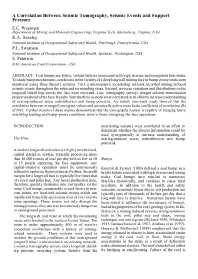Mining Publication: A Correlation Between Seismic Tomography, Seismic Events and Support Pressure
Original creation date: July 2001
Coal bumps are brittle, violent failures associated with high stresses and competent host strata. To study bump mechanisms, conditions in the vicinity of a deep longwall mining face in bump-prone strata were monitored using three discrete systems. First, a microseismic monitoring network recorded mining-induced seismic events throughout the mine and surrounding strata. Second, pressure variations and distributions on the longwall shield legs across the face were recorded. Last, tomography surveys imaged seismic transmission properties ahead of the face. Results from the three systems were correlated in an effort to increase understanding of mining-induced stress redistribution and bump potential. An initial, one-week study showed that the correlation between averaged tomogram values and seismically active areas had a coefficient of correlation (R) of 0.89. Further results of these studies demonstrate that the tomography system is capable of imaging heavy shield-leg loading and bump-prone conditions prior to them disrupting the face operations.
Authors: EC Westman, KA Heasley, PL Swanson, S Peterson
Conference Paper - July 2001
NIOSHTIC2 Number: 20021482
In: Elsworth D, Tinucci JP, Heasley KA, eds. Rock mechanics in the national interest, Proc 38th U.S. Rock Mechanics Symposium, Washington, DC, 2001 Jul; :319-326
See Also
- An Analysis of Flexural Strength and Crack Width for Fiber-Reinforced Shotcrete Used in Weak Rock Mines
- Detecting Strata Fracturing and Roof Failures from a Borehole Based Microseismic System
- Development of an Automated PC-Network-Based Seismic Monitoring System
- Diagnosing and Controlling Moisture-Sensitive Roof in Coal Mines
- Local Earthquake Tomography for Imaging Mining-Induced Changes Within the Overburden above a Longwall Mine
- Mapping Hazards with Microseismic Technology to Anticipate Roof Falls - A Case Study
- The Relationship of Roof Movement and Strata-Induced Microseismic Emissions to Roof Falls
- Safer Mine Layouts for Underground Stone Mines Subjected to Excessive Levels of Horizontal Stress
- Seismic Event Data Acquisition and Processing: Distribution and Coordination Across PC-Based Networks
- Time-Lapse Tomography of a Longwall Panel: A Comparison of Location Schemes
- Page last reviewed: 9/21/2012
- Page last updated: 9/21/2012
- Content source: National Institute for Occupational Safety and Health, Mining Program


 ShareCompartir
ShareCompartir
